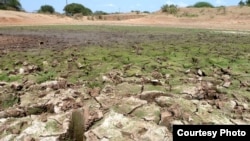A U.N. agency says 11 million people in Africa’s Sahel region still face severe food insecurity. At the same time, an emergency appeal for 113 million dollars has gone largely unmet.
The Food and Agriculture Organization says the Sahel has faced food insecurity crises in 2005, 2008 and again in 2012. Those crises, it says, have “eroded the capacity of the poor to maintain or restore their livelihoods.”
In Dakar, Patrick David, FAO’s deputy coordinator for food security analysis for West Africa and the Sahel, said, “There is still a lot of people in food insecurity. The people more and more find some difficulty to recover from the past crisis even if there is a good harvest because there have been pretty good harvests in 2012.”
David said many people in the Sahel depend on a few cattle and a small piece of land for survival. So, it’s hard for them to stock up any reserve food or agricultural supplies in the event of drought, conflict or bad harvest.
“While before it would take one or two years to recover, now it’s longer for those people to recover. It’s difficult to restock cattle, for example. It’s difficult for them to access agricultural credit to have good input[s] and to have fertilizer. And in some places in the Sahel, like in Burkina Faso and Niger, there [are] some dense populated area[s] where there is degradation of land and the loss of soil fertility. That means their agricultural
yield[s] are decreasing year by year,” he said.
That compounds the problems they already face as the price for grains, such as sorghum, millet and maize, continues to rise.
David said, “The poor and the very poor households, as soon as they’ve exhausted their little harvest, totally depend [on] the market. So they have to buy the grain at higher and higher prices. So their purchasing power is decreasing every year.”
Insecurity, such as the recent conflict in northern Mali, can also boost prices because agricultural products cannot get to market.
The FAO has appealed for $113 million for its programs in the Sahel. However, it’s only received less that $19.5 million so far.
“The intervention of FAO strengthens the resilience of the affected households. But when the affected households cannot receive the good seeds and the good fertilizer or cannot recapitalize their livestock, they stay very vulnerable and it’s a problem for the next year. So we definitely need additional support for the farmers and agriculture in order to decrease the impact of the forthcoming crisis,” he said.
Building resilience includes improving the storage, processing and transportation of goods – as well as livestock food supplements, animal health campaigns and herd restocking. The Food and Agriculture Organization programs also include fixing irrigation systems.
The FAO said it would like these programs to be in place – and making a difference – during the next growing season which runs from October through April
The Food and Agriculture Organization says the Sahel has faced food insecurity crises in 2005, 2008 and again in 2012. Those crises, it says, have “eroded the capacity of the poor to maintain or restore their livelihoods.”
In Dakar, Patrick David, FAO’s deputy coordinator for food security analysis for West Africa and the Sahel, said, “There is still a lot of people in food insecurity. The people more and more find some difficulty to recover from the past crisis even if there is a good harvest because there have been pretty good harvests in 2012.”
David said many people in the Sahel depend on a few cattle and a small piece of land for survival. So, it’s hard for them to stock up any reserve food or agricultural supplies in the event of drought, conflict or bad harvest.
“While before it would take one or two years to recover, now it’s longer for those people to recover. It’s difficult to restock cattle, for example. It’s difficult for them to access agricultural credit to have good input[s] and to have fertilizer. And in some places in the Sahel, like in Burkina Faso and Niger, there [are] some dense populated area[s] where there is degradation of land and the loss of soil fertility. That means their agricultural
yield[s] are decreasing year by year,” he said.
That compounds the problems they already face as the price for grains, such as sorghum, millet and maize, continues to rise.
David said, “The poor and the very poor households, as soon as they’ve exhausted their little harvest, totally depend [on] the market. So they have to buy the grain at higher and higher prices. So their purchasing power is decreasing every year.”
Insecurity, such as the recent conflict in northern Mali, can also boost prices because agricultural products cannot get to market.
The FAO has appealed for $113 million for its programs in the Sahel. However, it’s only received less that $19.5 million so far.
“The intervention of FAO strengthens the resilience of the affected households. But when the affected households cannot receive the good seeds and the good fertilizer or cannot recapitalize their livestock, they stay very vulnerable and it’s a problem for the next year. So we definitely need additional support for the farmers and agriculture in order to decrease the impact of the forthcoming crisis,” he said.
Building resilience includes improving the storage, processing and transportation of goods – as well as livestock food supplements, animal health campaigns and herd restocking. The Food and Agriculture Organization programs also include fixing irrigation systems.
The FAO said it would like these programs to be in place – and making a difference – during the next growing season which runs from October through April









